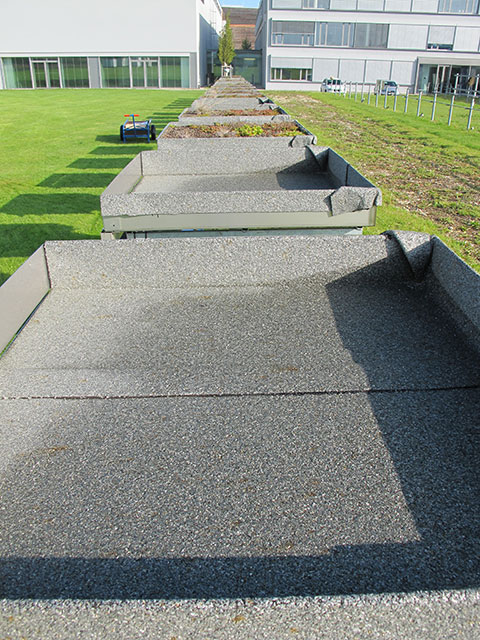Green roofs improve the quality of life in urban areas. However, radicides such as Mecoprop are needed to ensure that they function optimally. These protect the roofing membranes from root penetration. But how do these agents affect the environment? The amount of Mecoprop released by green roofing membranes was measured by Fraunhofer IBP scientists in a field test and two different laboratory tests. Commercially available roofing membranes containing different concentrations of the various Mecoprop esters were studied. While the laboratory tests were carried out under defined test conditions using small-format samples of the roofing membranes, the 18-month outdoor test used complete roof structures 1 m² in size. The roofing membranes were exposed to the weather both with and without extensive greening.
Release of root penetration inhibitors from green roofing membranes
Project goals
The results of the research project were intended to determine the extent to which run-off water from green roofs can pose a risk to soil and groundwater in the event of direct infiltration. A particular focus of interest was on whether the concentration of Mecoprop esters in the run-off water from bituminous green roofing membranes complies with the applicable environmental quality standard for surface waters, the lower threshold value for crop protection products and biocidal products (PSMBP) or the limit value set by the Drinking Water Ordinance for individual biocidal substances or active crop protection substances. The aim of comparing the substance concentrations released in laboratory and field tests was to gain information about the transferability of laboratory results to real conditions.
Stand des Projektes
The research project was completed in 2018.
The results serve as a basis for assessing the risks associated with run-off water contaminated with Mecoprop and its esters from bitumen waterproofing membranes impregnated with a radicide.
Among other things, the results were incorporated into an adaptation of a horizontal, standardized laboratory method for testing building products. The procedure for testing and evaluating the release of substances from bitumen roofing membranes is now laid down in the form of a test plan by the Deutsches Institut für Bautechnik DIBt in its requirements for construction products.
Project partners
- Fraunhofer Institute for Building Physics IBP
- Deutsches Institut für Bauchtechnik DIBt
